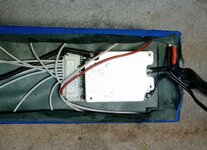Gionnirocket
Well-Known Member
- Region
- USA
- City
- Y. O.
I have a LiitoKala 48v/10ah battery that is only charging to 52.6v and shutting down at around 44v+/- when sagging to 43v+/- under load.
Some prior discussion on the pack here for those totally bored.
So after my ride today I decided to cut it open and see what's going on.
On first inspection @ 47.15v all groups were at 3.63v except for group #2 which was slightly lower at 3.59v
After a partial charge to 51v all groups were at 3.93v except for #2 which was now slightly higher at 4.05v
After an attempted full charge it shutdown down at 52.68v and all groups were at 4.04v except for #2 which was higher and at a full charge of 4.20v
This can be a malfunction of the BMS, but I'm thinking group #2 has a lower internal resistance and it's charging/discharging faster then the rest of the pack. Or there's a bad cell in the group basically causing the same effect.
So I'm thinking one work around would be to replace the simple BMS with a balancing BMS as it will cut charging to group #2 when it reaches 4.2v and then allow the others to catch up. This won't solve the faster discharge of that group but the battery as is already provides enough for my daily 20mi ride with at least another 10mi left in the tank.
Not really caring about salvaging it, but it's just another project to keep me out of trouble and keep my wheels turning with problem solving.
So.... am I missing something.. or does anyone have any experience with a similar situation? aaahem @tomjasz @harryS, @George S.
I'd ask Ravi K to chime in but I know he's jumping hoops right now trying to get Zens rolling
Current BMS

Some prior discussion on the pack here for those totally bored.
So after my ride today I decided to cut it open and see what's going on.
On first inspection @ 47.15v all groups were at 3.63v except for group #2 which was slightly lower at 3.59v
After a partial charge to 51v all groups were at 3.93v except for #2 which was now slightly higher at 4.05v
After an attempted full charge it shutdown down at 52.68v and all groups were at 4.04v except for #2 which was higher and at a full charge of 4.20v
This can be a malfunction of the BMS, but I'm thinking group #2 has a lower internal resistance and it's charging/discharging faster then the rest of the pack. Or there's a bad cell in the group basically causing the same effect.
So I'm thinking one work around would be to replace the simple BMS with a balancing BMS as it will cut charging to group #2 when it reaches 4.2v and then allow the others to catch up. This won't solve the faster discharge of that group but the battery as is already provides enough for my daily 20mi ride with at least another 10mi left in the tank.
Not really caring about salvaging it, but it's just another project to keep me out of trouble and keep my wheels turning with problem solving.
So.... am I missing something.. or does anyone have any experience with a similar situation? aaahem @tomjasz @harryS, @George S.
I'd ask Ravi K to chime in but I know he's jumping hoops right now trying to get Zens rolling
Current BMS


